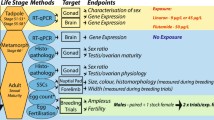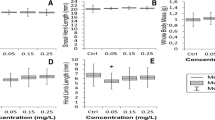Abstract
The triazine herbicide, atrazine, has come under scrutiny for its reported feminizing effects in amphibians. To date, there is little information concerning the effects of atrazine on reproduction in avian species. The current study examined the putative reproductive toxicity of atrazine after exposure in ovo. Atrazine at 504, 246, and 123 μg/kg was administered to Japanese quail eggs before incubation. The eggs were hatched and the birds raised to 14 days of age. Indices of hatchability, sex ratios, and growth were determined. Furthermore, circulating concentrations of reproductive hormones (estradiol, progesterone, and testosterone) and gonadal histology were examined. Atrazine at 504 μg/kg decreased 14-day hatchling weight by 13.1% versus controls. However, no detrimental effects on hatchability or sex ratios were observed. In female birds, atrazine at 504 μg/kg decreased ovarian weights and circulating concentrations of progesterone to 48.3% and 73.3%, respectively, versus control. However, concentrations of estradiol and testosterone did not differ from controls. In male quail, at all doses tested, atrazine had no effect on gonadal weights or circulating concentrations of estradiol, testosterone, or progesterone. Moreover, no incidences of left ovotestis formation were observed. In contrast, 10 ng/kg ethinylestradiol (a positive control) induced the formation of a left ovotestis in four of eight birds analyzed. The current results may suggest that exposure to atrazine in ovo at concentrations above ecologic relevance exerts effects on the reproductive system of young Japanese quail. However, no evidence is presented that atrazine induces feminization of the testis in male quail.

Similar content being viewed by others
References
Babic-Gojmerac T, Kniewald Z, Kniewald J (1989) Testosterone metabolism in neuroendocrine organs in male rats under atrazine and desethylatrazine influence. J Steroid Biochem 33:141–146
Berg C, Halldin K, Fridolfsson AK, Brandt I, Brunstrom B (1999) The avian egg as a test system for endocrine disrupters: Effects of diethylstilbestrol and enthynylestradiol on sex organ development. Sci Total Environ 233:57–66
Butkauskas D, Sruoga A (2004) Effect of lead and chromium on reproductive success of Japanese quail. Environ Toxicol 19:412–415
Cooper RL, Stoker TE, Goldman JM, Parrish MB, Tyrey L (1996) Effect of atrazine on ovarian function in the rat. Reprod Toxicol 10:257–264
Cooper RL, Stoker TE, Tyrey L, Goldman JM, McElroy WK (2000) Atrazine disrupts the hypothalamic control of pituitary-ovarian function. Toxicol Sci 53:297–307
Cummings AM, Rhodes BE, Cooper RL (2000) Effect of atrazine on implantation and early pregnancy in 4 strains of rats. Toxicol Sci 58:135–143
Eldridge JC, Wetzel LT, Tyrey L (1999) Estrous cycle patterns of Sprague-Dawley rats during acute and chronic atrazine administration. Reprod Toxicol 13:491–499
Foster TS, Kahn SU (1976) Metabolism of atrazine by the chicken. J Agric Food Chem 24:566–70
Graymore M, Stagnitti F, Allinson G (2001) Impacts of atrazine in aquatic ecosystems. Environ Int 26:483–495
Gojmerac T, Kartal B, Curic S, Zuric M, Kusevic S, Cventnic Z (1996) Serum biochemical changes associated with cystic ovarian degeneration in pigs after atrazine treatment. Toxicol Lett 85:9–15
Gojmerac T, Uremovic M, Uremovic Z, Curic S, Bilandzic N (1999) Reproductive disturbance caused by an S-triazine herbicide in pigs. Acta Vet Hung 47:129–135
Gojmerac T, Pleadin J, Zuric M, Rajkovic-Janje R, Korsic M (2004) Serum luteinizing hormone response to administration of gonadotropin-releasing hormone to atrazine-treated gilts. Vet Hum Toxicol 46:245–247
Halldin K (2005) Impact of endocrine disrupting chemicals on reproduction in Japanese quail. Domestic Anim Endocrinol 29:420–429
Hayes T, Haston K, Tsui M, Hoang A, Haeffele C, Vonk A (2003) Atrazine-induced hermaphroditism at 0.1 ppb in American leopard frogs (Rana pipiens): Laboratory and field evidence. Environ Health Perspect 111:568–575
Hayes TB, Collins A, Lee M, Mendoza M, Noriega N, Stuart AA, et al. (2002) Hermaphroditic, demasculinized frogs after exposure to the herbicide atrazine at low ecologically relevant doses. Proc Natl Acad Sci U S A 99:5476–5480
Kiernan JA (1999) Histological & histochemical methods. Theory and practice. Reed Educational and Professional Publishing, Woburn, MA
Kniewald J, Gojmerac T, Simic B, Kniewald Z (1989) Biodegradation of atrazine and the impact on reproductive system in mammals and avians—Comparative study. In: Lokke H, Tyle H, Bro-Rasmussen F (eds) Proceedings of the 1st European Conference on Ecotoxicology. The Technical University of Denmark, Lyngby, Denmark p 93
Kniewald J, Osredecki V, Gojmerac T, Zechner V, Kniewald Z (1995) Effect of s-triazine compounds on testosterone metabolism in the rat prostate. J Appl Toxicol 15:215–218
Laws SC, Ferrell JM, Stoker TE, Schmid J, Cooper RL (2000) The effects of atrazine on female Wistar rats: An evaluation of the protocol for assessing pubertal development and thyroid function. Toxicol Sci 58:366–376
Laws SC, Ferrell JM, Stoker TE, Cooper RL (2003) Pubertal development in female Wistar rats following exposure to propazine and atrazine biotransformation by-products, diamino-s-chlorotriazine and hydroxyatrazine. Toxicol Sci 76:190–200
Mather FB, Wilson WO (1964) Post-natal testicular development in Japanese quail (Coturnix coturnix japonica). Poult Sci 43:860–864
McMurry CS, Dickerson RL (2001) Effects of binary mixtures of six xenobiotics on hormone concentrations and morphometric endpoints of northern bobwhite quail (Colinus virginianus). Chemosphere 43:829–837
National Research Council (1994) Nutrient requirements of poultry: Ninth revised edition. Board on Agriculture. National Academies Press, Washington, DC
Ottinger MA, Abdelnabi MA, Henry P, McGary S, Thompson N, Wu JM (2001) Neuroendocrine and behavioral implications of endocrine disrupting chemicals in quail. Horm Behav 40:234–247
Ottinger MA, vom Saal FS (2002) Impact of environmental endocrine disruptors on sexual differentiation in birds and mammals. In: Pfaff D, Arnold A, Etgen A, Rubin R (eds) Hormones, brain and behavior. Volume 4. Academic, San Diego, CA, pp 325–383
Pensabene JW, Fiddler W, Donoghue DJ (2000) Supercritical fluid extraction of atrazine and other triazine herbicides from fortified and incurred eggs. J Agric Food Chem 48:1668–1672
Rayner JL, Wood C, Fenton SE (2004) Exposure parameters necessary for delayed puberty and mammary gland development in Long-Evans rats exposed in utero to atrazine. Toxicol Appl Pharmacol 195:23–34
Roberge M, Hakk H, Larsen G (2004) Atrazine is a competitive inhibitor of phosphodiesterase but does not affect the estrogen receptor. Toxicol Lett 154:61–68
Sanderson JT, Seinen W, Giesy JP, van den Berg M (2000) 2-Chloro-s-triazine herbicides induce aromatase (CYP19) activity H295R human adrenocortical carcinoma cells: A novel mechanism for estrogenicity? Toxicol Sci 54:121–127
Selzsam B, Niemann L, Gericke C, Chahoud I (2005) Suitability of some additional parameters in reproduction studies in Japanese quail: preliminary experience. Avian Poult Biol Rev 16:41–46
Shimabukuro RH, Swanson HR (1969) Atrazine metabolism, selectivity and mode of action. J Agric Food Chem 17:199–205
Stoker TE, Laws SC, Guidici DL, Cooper RL (1999) Maternal exposure to atrazine during lactation suppresses suckling-induced prolactin release and results in prostatitis in the adult offspring. Toxicol Sci 52:68–79
Stoker TE, Laws SC, Guidici DL, Cooper RL (2000) The effect of atrazine on puberty in male Wistar rats: An evaluation in the protocol for the assessment of pubertal development and thyroid function. Toxicol Sci 58:50–59
Stoker TE, Guidici DL, Laws SC, Cooper RL (2002) The effects of atrazine metabolites on puberty and thyroid function in the male Wistar rat. Toxicol Sci 67:198–206
Tennant MK, Hill DS, Eldridge JC, Wetzel LT, Breckenridge CB, Stevens JT (1994) Possible antiestrogenic properties of chloro-s-triazines in rat uterus. J Toxicol Environ Health 43:183–196
Trentacoste SV, Friedmann AS, Youker RT, Breckenridge CB, Zirkin BR (2001) Atrazine effects on testosterone levels and androgen-dependent reproductive organs in peripubertal male rats. J Androl 22:142–148
United States Environmental Protection Agency (2002) Reregistration eligibility. Science chapter for atrazine: Environmental fate and effects. Office of Prevention, Pesticides and Toxic Substances, United States Environmental Protection Agency, Washington, DC
United States Environmental Protection Agency (2004) Pesticides industry sales and usage: 2000 and 2001 market estimates. Office of Prevention, Pesticides and Toxic Substances, United States Environmental Protection Agency, Washington, DC. Available at: http://www.epa.gov/oppbead1/pestsales/01pestsales/market_estimates2001.pdf. Accessed December 23, 2004
Wilhelms KW, Cutler SA, Proudman JA, Anderson LL, Scanes CG (2005) Atrazine and the hypothalamo-pituitary-gonadal axis in sexually maturing precocial birds: Studies in male Japanese quail. Toxicol Sci 86:152–160
Acknowledgments
We acknowledge Jin Sook Lee for assistance with photomicroscopy. This study was funded by a special grant from the Center for Designing Foods to Improve Nutrition, Iowa State University, Ames, IA.
Author information
Authors and Affiliations
Corresponding author
Rights and permissions
About this article
Cite this article
Wilhelms, K.W., Fitzpatrick, K.F., Scanes, C.G. et al. In Ovo Exposure to a Triazine Herbicide: Effects of Atrazine on Circulating Reproductive Hormones and Gonadal Histology in Young Japanese Quail. Arch Environ Contam Toxicol 51, 117–122 (2006). https://doi.org/10.1007/s00244-005-0165-x
Received:
Accepted:
Published:
Issue Date:
DOI: https://doi.org/10.1007/s00244-005-0165-x




